The simple picture of star formation calls for giant clouds of gas and dust to collapse inward due to gravity, growing denser and hotter until igniting nuclear fusion. In reality, forces other than gravity also influence the birth of stars. New research shows that cosmic magnetic fields play a more important role in star formation than previously thought.
A molecular cloud is a cloud of gas that acts as a stellar nursery. When a molecular cloud collapses, only a small fraction of the cloud’s material forms stars. Scientists aren’t sure why.
Gravity favors star formation by drawing material together, therefore some additional force must hinder the process. Magnetic fields and turbulence are the two leading candidates. A magnetic field is produced by moving electrical charges. Stars and most planets, including Earth, exhibit magnetic fields. Magnetic fields channel flowing gas, making it hard to draw the gas from all directions, while turbulence stirs the gas and induces an outward pressure that counteracts gravity.
“The relative importance of magnetic fields versus turbulence is a matter of much debate,” said astronomer Hua-bai Li of the Harvard-Smithsonian Center for Astrophysics, Cambridge, Massachusetts. “Our findings serve as the first observational constraint on this issue.”
Li and his team studied 25 dense patches, or cloud cores, each one about a light-year in size. The cores that act as seeds from which stars form were located within molecular clouds as much as 6,500 light-years from Earth. A light-year is the distance light travels in a year, or 6 trillion miles.
The researchers studied polarized light, which has electric and magnetic components that are aligned in specific directions. From the polarization, they measured the magnetic fields within each cloud core and compared them to the fields in the surrounding, tenuous nebula.
The magnetic fields tended to line up in the same direction, even though the relative size scales — 1 light-year cores versus 1,000 light-year nebulas — and densities were different by orders of magnitude. Since turbulence would tend to churn the nebula and mix up magnetic field directions, their findings show that magnetic fields dominate turbulence in influencing star birth.
“Our result shows that molecular cloud cores located near each other are connected not only by gravity but also by magnetic fields,” said Li. “This shows that computer simulations modeling star formation must take strong magnetic fields into account.”
In the broader picture, this discovery aids our understanding of how stars form and, therefore, how the universe has come to look the way it is today.










